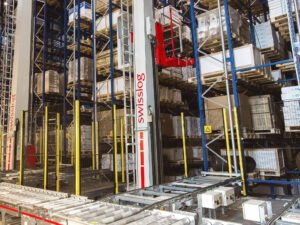Warehouse is one of the most crucial spaces in an industrial setup and its efficiency is crucial for the success of a business. A warehouse has a lot of products that need appropriate management. Hence, to enhance the accuracy and efficiency of your warehouse, you can read the guide below. It will help you learn how to manage warehouse inventory. So, let’s read.
Understanding Warehouse Inventory Management
Warehouse inventory management involves the process of looking after, maintaining, controlling, and optimizing the storage and movement of the goods in a warehouse.
The process of warehouse management ensures that the levels of inventory are accurate and are stored and aligned keeping in line with the demand. It helps with reducing wastage as well as overstocking. The key components that play a vital role in the management of warehouse inventory are as follows:
- Tracking: Technological innovations like barcode scanning help monitor the status and location of the inventory and streamline the records and retrievals.
- Forecasting: It offers an analysis of the market trends so that future demand can be predicted and the optimal stock levels are maintained.
- Optimization: Optimization offers to enhance storage efficiency helps with the process of packing and picking and enhances cost-effectiveness and speed.
Best Practices for Managing Warehouse Inventory
Some of the best practices that play a vital role in the warehouse inventory management process are highlighted in the section below.
Implementing an Inventory Management System (IMS):
The implementation of automated inventory management systems reduces the chance of human errors and enhances efficiency by saving time. Real-time tracking offers to keep track of the stock levels concerning the stock management. However, some of the features to consider when implementing the inventory management systems are as follows:
- The IMS should integrate with the existing systems like other sales software or any ERP that is used by the business. It improves the operational efficiency.
- It is important to choose such a system that can grow with the businesses. In the future when the operations expand it can accommodate the expansion.
- It should be easy to use with minimal training required for the staff.
Regular Inventory Audits:
Regular check and balances helps to analyze the accuracy of the inventory level. By performing regular inventory audits, the accuracy can be maintained and the discrepancies from the day-to-day operations can be eliminated.
To ensure accuracy, barcode scanners, reconciliation processes, and other methodologies should be introduced so that the data can be cross-verified.
Demand Forecasting:
The forecasting of demand can be done by analyzing the sales in the past and also considering the market changes and the seasonal trends. The quantity of the products should be matched to the forecasted demand so that overstocking and understocking are prevented.
ABC Analysis:
The ABC analysis is rating the products into categories as given below:
- A: It offers to cater to products that have high value and need highly accurate forecasting.
- B: It comprises products that have a moderate value and need balanced monitoring.
- C: Such items of low value have high turnover and need less intense management.
It helps you prioritize the resources so that the A-category items can be monitored efficiently to maximize profits.
Just-In-Time (JIT) Inventory:
Just In Time inventory storage is a process that helps in reducing the cost associated with holding the products. You can implement it so that the space and cost involved in holding products are eliminated and the goods are ordered only when needed.
However, the JIT method requires a stable forecast of demands and timely deliveries by suppliers so that sudden demands are met.
Safety Stock Management:
The safety stock management helps in holding some safe stock so that in case there is any spike in demand it could be met. By keeping the safety stock based on the demand you can prevent disruptions. Also, look for striking a balance where the safety stock is held without adding to the cost.
Modular shelves can be used for the safety stock so that the space for the regular stock is not compromised. Such racking systems are quite flexible and adapt to the changing demands.
Warehouse Layout and Design
The layout and design of the warehouse also play a crucial role in maintaining the inventory Some important aspects to consider in this regard are as follows:
Optimizing Space Utilization:
The space utilization should be optimized in the best possible way and some options to consider are as follows:
- By implementing the vertical racking systems, the warehouse space can be maximized. It ensures that the floor area is free from inventory.
- Organization of aisles also helps with smooth traffic flow and offers easy access to inventory. When the aisles are narrow they can enhance the storage density. However, make sure that they can also allow the movement of equipment.
- Storage solutions like high-density shelves, and pallet racks can be quite useful as they offer enhanced accessibility and efficiency.
Efficient Picking Strategies:
The picking strategies can also be adopted with some efficiency so that warehouse management is achieved optimally.
- Look for grouping the multiple orders so that they can be collected in one go. It helps in reducing the time to travel and also fastens the process of order fulfillment.
- You can also divide your warehouse into zones. Every picker has a zone specified and the orders are moved through the different zones. It reduces the congestion in the warehouse and the laborers work efficiently.
- Light-directed techniques are also implemented. By implementing these the pickers can be guided to the exact location to speed up the process and reduce the chances of errors.
Implementing FIFO and LIFO Systems:
Different systems of inventory management are useful when it comes to considering how to manage warehouse inventory. The two most popular inventory management methods are discussed below:
- FIFO: It ensures that the older inventory is sold before the new stock, it helps reduce waste and manage perishable products.
- LIFO: LIFO gives priority to selling the items that have been added to the inventory at the latest. It is suitable for goods that are not perishable.
Leveraging Technology in Inventory Management
Implementation of technology in inventory management helps in managing the goods in a warehouse efficiently. Some of these methods are discussed below:
Barcode and RFID Systems:
The implementation of RFID and barcodes both allows for streamlining of the tracking process of inventory. It even reduces human errors and the codes printed can be read by the barcode to identify the items. Whereas RFID can use radio waves to identify the items even if they are not in the direct line of sight.
Barcode scanners are affordable and suitable for small-sized warehouses with limited inventory. RFID has a high initial investment but offers to scan multiple goods in one go which is suitable for larger warehouses with huge inventory.
Warehouse Management Systems (WMS):
The implementation of warehouse management systems requires some features to consider which are as follows:
- The system must offer instant updates on the level of inventory followed by the status of the order. Due to this accuracy and efficiency in the warehouse operations can be achieved.
- The tools offered by the system must offer an insight into the trends, and performance of each product to identify areas of improvement.
- These systems should be compatible with the existing systems like accounting and ERP so that consolidated data management is achieved.
Automation and Robotics:
Warehouse optimization even involved using automation and robotic systems. There are various ways these could help as follows:
- The automated guided vehicles transport the goods through the warehouse automatically. It reduces the burden on staff as well as speeds up the picking process.
- Robotic picking systems have sensors so that the robots can pick and place the products accurately without any error.
These methods help to reduce the dependency on labor and in the long run savings on labor cost can be achieved. It also allows to conduct operations throughout the day which speeds up the order fulfillment and reduces the chance of eros.
Staff Training and Development
The warehouse inventory management is also dependent on the skills of the staff. If the staff is well trained it could add to the efficiency of a warehouse in significant ways.
Importance of Skilled Personnel:
Appropriate training of staff plays a crucial role in improving the warehouse functions appropriately. The staff should have enough knowledge about the right product, store it properly and pack it correctly. It helps to streamline overall operations and also enhances accuracy and reduces the damage to the goods.
The staff should also be kept updated on the latest tools for inventory management, and the working mechanisms of automated equipment. They must know how to use barcode scanners and how to keep a check on the inventory levels using these systems.
Establishing Standard Operating Procedures (SOPs):
An efficient warehouse should have SOPs in place for handling inventory. It helps the staff to receive, store, pick, and pack the goods according to the required protocol. Detailed documentation should be given to the staff. It helps to inform them what their responsibilities are and what steps they should take for appropriate inventory management.
The implementation of SOPs tends to standardize the process and the chances of errors are minimized. It even helps to ensure consistency in the warehouse operations and the overall efficiency increases.
Monitoring and Continuous Improvement
Keeping a check and balance on the improvements plays a very major role. It helps enhance the overall performance of the staff and even the management of warehouse inventory. Some of the aspects for such improvement are as follows:
Key Performance Indicators (KPIs):
Some key performance indicators that help in assessing the improvement comprise the following:
- You can check the inventory turnover ratio to analyze the patterns of sales. It indicates how often particular products are sold and when they need a replacement. It helps to point out the items that are slow moving and protects from overstocking.
- The repetition of the order helps you track the correct picking, packing, and also shipping to the customers. It helps analyze customer satisfaction.
You should make some realistic goals against which you can measure the performance of these indicators and check if there is an improvement or not.
Regular Review and Adaptation:
Timely review is crucial for the consistency of the inventory management processes. The need to analyze the KPIs and identify the areas of improvement followed by customer feedback helps in warehouse management.
One must always stay informed about the trends and demands that ensure they are met to enhance the warehouse’s operational efficiency.
Conclusion
Managing warehouse inventory requires the right utilization of space and the implementation of the appropriate racking systems. We at Lracking offer to design custom racking solutions that are according to your specific requirements. Hence, they can help manage and store your inventory efficiently. So, when it comes to enhancing your warehouse efficiency, get in touch with us.




